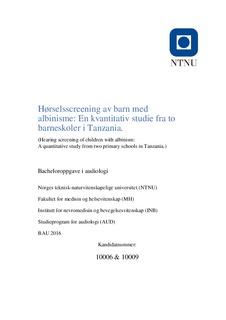| dc.contributor.advisor | Øygarden, Jon | |
| dc.contributor.author | Hagan, Tobias Bang | |
| dc.contributor.author | Hansen, Giske Sindberg | |
| dc.date.accessioned | 2019-09-06T14:03:18Z | |
| dc.date.available | 2019-09-06T14:03:18Z | |
| dc.date.issued | 2019 | |
| dc.identifier.uri | http://hdl.handle.net/11250/2613275 | |
| dc.description.abstract | Formål:
Formålet med denne studien var å finne eventuelle sammenhenger mellom diagnosen albinisme og hørselstap. Gjennomføringen bestod av hørselsutredning ved to lokale barneskoler i Tanzania.
Metode og deltakere:
Det ble gjennomført en kvantitativ datainnsamling av totalt 299 barn. Det totale antallet var fordelt på 72 barn med albinisme, samt en kontrollgruppe på 227 barn uten albinisme. Datainnsamlingen bestod av hørselsscreening der de barna som fikk påvist hørselstap (>20 dB HL) også ble otoskopert. De mulige årsakene for barnas hørselsnedsettelse ble fortolket ut fra de funnene som ble gjort av hørselsscreening og otoskopi. Resultatene ble grafisk fremstilt, og analyse av gruppene ble gjort med Fisher’s Exact test.
Resultat:
Under datainnsamling ble det påvist hørselstap hos til sammen 52 barn. Av disse var det 21 barn med albinisme og 31 barn uten albinisme. Totalt var det flere barn med funn av hørselstap ved skole 2 sammenlignet med skole 1. Det var derimot ingen signifikant forskjell på prevalensen fordelt på kjønn.
Funn fra otoskopi viste en høyere andel mekaniske komponenter som mulig årsak for hørselsnedsettelse. Majoriteten av barna med slike funn hadde symptomer som kunne tolkes til å komme av blant annet otitis media.
Konklusjon:
På bakgrunn av resultatene kan det konkluderes med en ikke signifikant forskjell på prevalens av hørselstap mellom de to gruppene. Likevel indikerer resultatene at det var flere mulige mekaniske hørselstap enn sensorineurale. Dette kan tolkes til å ha en generell sammenheng med andre årsaksfaktorer som hygiene og smittefare. | |
| dc.description.abstract | Objectives:
The purpose of this study was to find evidence for a correlation between albinism and hearing loss. The hearing assessments were carried out at two local primary schools in Tanzania.
Method and participants:
We also performed an otoscopy on the children we discovered had hearing loss (>20 dB HL).
The possible causes of the children’s hearing loss were interpreted based on the findings from the hearing screening as well as the otoscopy. The results were graphically presented and the analysis of the groups was done with Fisher’s Exact test.
Results:
Hearing loss was detected in a total of 52 children. Of these, 21 were children with albinism and 31 children without albinism. In total, there were more children with findings of hearing loss at school 2 compared to school 1. On the other hand, there was no significant difference in prevalence by gender.
Findings from otoscopies indicates that there were a higher prevalence of conductive components as a possible cause for the children’s hearing loss, with the majority of the children having symptoms pointing at otitis media as cause.
Conclusions:
Based on the results, the conclusion is that no significant difference can be proven between the two groups. Nevertheless, the results indicate that there were more possible conductive hearing losses than sensorineural. This can be interpreted as having a general connection with other causal factors such as hygiene and risk of infections. | |
| dc.language | nob | |
| dc.publisher | NTNU | |
| dc.title | Hørselsscreening av barn med albinisme: En kvantitativ studie fra to barneskoler i Tanzania. | |
| dc.type | Bachelor thesis | |
